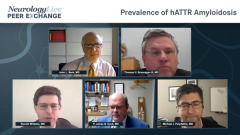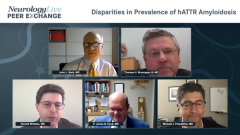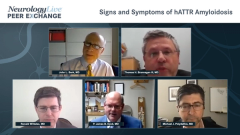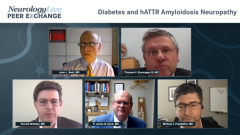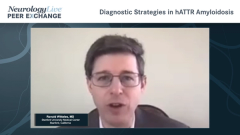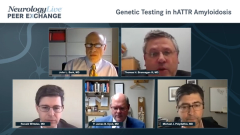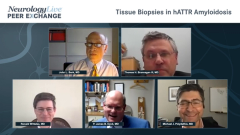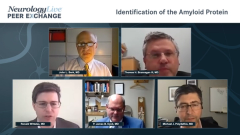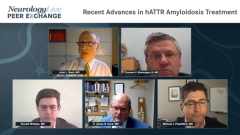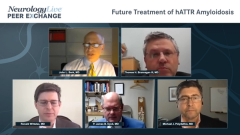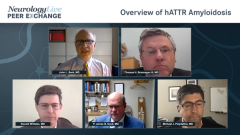
Signs and Symptoms of hATTR Amyloidosis
Signs and symptoms to help determine a diagnosis of hereditary ATTR.
Episodes in this series

John L. Berk, MD: Dr Dyck, you mentioned the symptom complex that we should be alert for. Could you describe the timing and importance of carpal tunnel syndrome with regard to ultimate expression of the full polyneuropathy, and give us an idea of exactly how that polyneuropathy appears?
P. James B. Dyck, MD: I think it’s an important question. Patients who develop hATTR [hereditary ATTR amyloidosis] often will present with carpal tunnel syndrome first. It is often an early manifestation; it is often on both sides, and then they will often develop a peripheral neuropathy. Now the problem with the peripheral neuropathy is its variable in its progression. However, once it starts, on average it is a progressive neuropathy. We will go on and discuss the different treatments, but one of the reasons these different trials worked is that hATTR neuropathy tends to progress at a rapid pace once it begins. These treatments were able to show efficacy because the placebo patients’ neuropathy worsened at quite an alarming pace, and so you could show an efficacy for these treatments.
What is that neuropathy? That neuropathy tends to be quite a bit of pain: sharp, stabbing pain, prickling and tingling, numbness. It’s associated with a lot of autonomic symptoms, lightheadedness, erectile dysfunction is very common, GI [gastrointestinal] symptoms, diarrhea, and constipation are very common, sometimes urinary symptoms, and then they often will develop progressive weakness. As I said, early on it’s nonspecific, but as it progresses it becomes much more specific.
Dr Brannagan mentioned CIDP. I think in general, chronic inflammatory demyelinating polyradiculoneuropathy, or CIDP, doesn’t look much like hATTR. That is a motor-predominant polyradiculoneuropathy, where hATTR tends to give you quite a bit of pain, quite a bit of sensory loss, quite a bit of autonomic symptoms. That pain and that autonomic neuropathy would be atypical for CIDP.
John L. Berk, MD: Thank you. Dr Brannagan, do you agree with that characterization, and can you give us a bit of insight on how the disease appears in progression?
Thomas H. Brannagan III, MD: I would agree with that. There’s CIDP, which is a motor-predominant neuropathy with proximal and distal weakness. That is usually very different from TTR amyloid, which typically presents as a distal predominant painful neuropathy with prominent autonomic symptoms. There are a number of publications of patients who have been diagnosed with CIDP before they were eventually diagnosed with TTR, and I have seen a small number of patients myself who were sent to me for refractory CIDP. I have to admit when I saw them, they did have very prominent weakness, and they often did not have prominent autonomic symptoms. I think what moved us away from the diagnosis of CIDP first was they did not respond to typical CIDP treatments and the electrophysiology. My own patients and the majority of the published cases did not show prominent demyelination; they did show signs of axonal degeneration on the nerve connections.
John L. Berk, MD: Dr Polydefkis, the gastrointestinal symptoms of disease are due to amyloid build-up in the wall of the intestine or for some other mechanism?
Michael J. Polydefkis, MD: I think it’s both nerve and local infiltration, the combination of both. Patients often have many symptoms: early satiety, bloating, a paradoxical combination of constipation and diarrhea.
John L. Berk, MD: Thank you. Dr Witteles, as our resident cardiologist, what are the cardiac manifestations you look for? What distinguishes TTR amyloid cardiomyopathy from other cardiomyopathies?
Ronald Witteles, MD: The typical phenotype will be of a thick heart, so it will often get called left ventricular hypertrophy [LVH]. It’s not hypertrophy truly, it’s an amyloid infiltration, but it will get called that on imaging. Everything is thick, not only the left ventricle, but the right ventricle; you’ll see often thickening of the valves, etc. What often gets taught or people seem to remember are low voltages on the electrocardiogram [EKG]. I would emphasize that that is frequently not present, particularly in transthyretin cardiomyopathy as opposed to other amyloid cardiomyopathies like AL [amyloid light chain]. If anything, you’re going to see a relative lack of a typical LVH pattern on EKG despite the increased wall thickness. Even there, I have many, many patients with ATTR cardiomyopathy who have frankly normal or high voltages, so I’d say to sort of take that away. There’s a very high proportion of patients who have arrhythmias, in particular heart block. Heart block is very common, even more so than in other forms of amyloidosis, but ventricular arrhythmias and certainly atrial arrhythmias like atrial fibrillations happen as well. Then of course, they can have heart failure. It’s a predominantly diastolic heart failure or a heart failure with preserved ejection fraction, but if the disease progresses, people can have systolic heart failure. What I’d emphasize is that for the patients who have predominance of neuropathic involvements, usually those symptoms do predominate, and they may have no cardiovascular symptoms whatsoever. Because they often have so much autonomic insufficiency and are in a sense very vasodilated, they may not have some of those typical findings that cardiologists will often associate with heart failure. It’s only by screening them when you get an echocardiogram and an EKG that it becomes apparent that they have amyloid infiltration in the heart as well.
John L. Berk, MD: Thank you for watching this NeurologyLive® Peer Exchange. If you enjoyed the content, please subscribe to our e-newsletters to receive upcoming Peer Exchanges and other great content right in your inbox.
Transcript Edited for Clarity
Newsletter
Keep your finger on the pulse of neurology—subscribe to NeurologyLive for expert interviews, new data, and breakthrough treatment updates.

